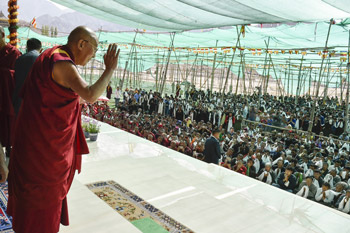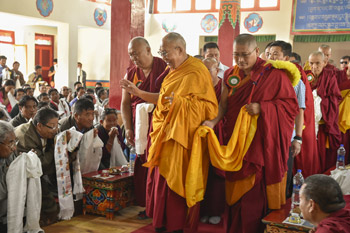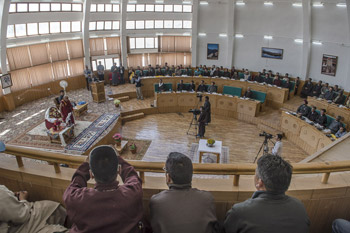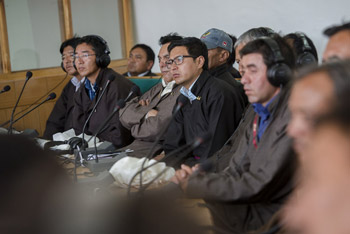Leh, Ladakh, J&K, India, 15 July 2014 - On reaching the teaching pavilion at Shiwatsel this morning, His Holiness the Dalai Lama went directly to the eastern door of the mandala palace and surveyed the sand mandala. Looking up from that he nodded in respect to the grand appliqué thangka of Kalachakra hanging behind the western door. Then he walked over to where the monks of Namgyal Monastery were reciting Kalachakra rituals, smiled and stepped out to the front of the pavilion. Assembled before him were members of the 9,000 volunteers who had assisted with the successful conduct of the 33rd Kalachakra Empowerment. He addressed them:

|
His Holiness the Dalai Lama greeting the over 9,000 volunteers who worked at the 33rd Kalachakra Empowerment in Leh, Ladakh, J&K, India on July 15, 2014. Photo/Manuel Bauer
|
“I know you’ve been making preparations for this event for months. The main group of attendees were Ladakhis and I’d like to thank you for the kind reception you gave them. All of you have worked hard, not for money or fame, nor even for your own amusement. You have created a great deal of merit and in the Buddhist tradition it is important in the context of gathering merit and eliminating negativities to dedicate it at the end. What’s more, you create even greater merit if you act generously, as you all have, at a time when the Dharma is declining.”
He said that towards the end of the 20th century and now at the beginning of the 21st many people from countries where Buddhism was not traditional have been showing interest. Because of this there were about 6,000 foreign guests. He said, they may go away with an impression of Ladakh as a dry, dusty place, but they were happy and will take happy memories home with them.
“For that too, I thank you.”
A short drive from Shiwatsel into the Choglamsar Tibetan Settlement brought His Holiness to Rudok Monastery, a branch of Sera Jey that has recently been extended. He was received on arrival by Sharpa Chojey Rinpoche and the abbot. Ribbons across the door of the new debating hall were arranged so that when His Holiness pulled on the one in the middle the others fell away signifying inauguration as the doors were pushed open. Once everyone had sat down the assembled monks recited the Praise to the Seventeen Masters of Nalanda.

|
His Holiness the Dalai Lama arriving at the new debating hall at Rudok Monastery in Chglamsar Tibetan Settlement near Leh, Ladakh, J&K, India on July 15, 2014. Photo/Manuel Bauer
|
“Now you have expanded this Rudok Gompa,” His Holiness said, “the purpose should be to provide the public with opportunities to gain a Dharma education.”
Addressing a group of Singaporean donors, who had backed the project, he said:
“I’d like to thank you for supporting this monastery. It will be good if it can become a learning centre. I request every Tibetan monastery I visit these days to become a centre of learning, rather than just a place to perform rituals and prayers. I’d like to see them become places where the Nalanda tradition can be passed on and where people can learn how to deal with disturbing emotions.
“As far as material development is concerned, many of the problems we face we create ourselves, mostly because of a lack of moral principles, a sense of respect for other’s life and rights. We will not change this by making prayers alone; we need to use our intelligence. Many of my scientist friends approve of such a return to human values. Because we are social animals, we have to learn to serve others. We need love and compassion; bearing in mind that love and compassion are not the exclusive preserve of Buddhists! What we need to do is present Buddhist ideas in ways that can benefit anybody. To explain how the mind and emotions work so that anyone can understand should be our goal.”

|
His Holiness the Dalai Lama exchanging greetings with a member of the Ladakh Autonomous Hill Development Council (LAHDC) in Leh, Ladakh, J&K, India on July 15, 2014. Photo/Tenzin Choejor/OHHDL
|
His Holiness was next made welcome at the Ladakh Autonomous Hill Development Council, Leh (LAHDC), where he was ushered into the council chamber. The Chief Executive Councillor, Rigzin Spalbar said he would like to give a brief overview of the 18 year existence of the LAHDC. He said that Ladakh is a region of strategic importance, which has led to many ups and downs in the Ladakhi way of life. The focus of that way of life includes an optimum use of resources and a strong desire to preserve traditional values, while at the same time embracing modernity. Agitation in 1995 for a greater local role in decision making led to the establishment of the LAHDC. His Holiness responded:
“Thank you for the opportunity to meet you all. Thank you too for the account of your activities. You have faced hardships, but by and large have coped with them. I have no special contribution to make because I am only a guest here, but for many years we have been close friends. I congratulate you on surmounting the hardships and difficulties you have faced.
“Your plans for the future are good. Now implementation is in order. Otherwise you know better than I what your needs are. One thing I would like to talk to you about though is education. I have the opportunity to visit universities in countries all over the world. Many scientists, educationists and thinkers agree that our existing education systems are inadequate. Not enough time is given to inner values and ethics. I tell people that we need a more complete system of education that includes training in ethics; secular ethics. India’s constitution is based on secularism, a respect for all religious traditions and even individuals who have none. Secular ethics is appropriate for modern society.”

|
Members of the Ladakh Autonomous Hill Development Council (LAHDC) listening to His Holiness the Dalai Lama in Leh, Ladakh, J&K, India on July 15, 2014.
Photo/Tenzin Choejor/OHHDL
|
His Holiness said that many he speaks to agree, but do not know how to introduce secular ethics. Consequently, there are now concerned people working to develop a curriculum that can be piloted in one or two schools. If it is found to be helpful, it can be extended to others. The best approach to developing society takes account of its members’ rights and aspirations. He said that if you exploit and bully others it will not help you. He pointed out that scientists have shown that constant fear and anger damages our immune system, while warm-heartedness is good for our health.
“I’m not talking about God, Allah or Buddha, but about developing a better society, which all revolves around education. We need to think of belonging to one human family. If we can do that, there is a chance that by the end of the 21st century we can create a happier, more peaceful society. This depends on what we do, not on who we pray to. We need to work hard with self-confidence. The 7 billion human beings alive today are our brothers and sisters; therefore we need cooperation based on trust and self-confidence to create an open, compassionate, harmonious society. Here in Ladakh you have long been living in harmony, you must work hard to keep it up.”
His Holiness was invited to lunch, during which conversation with councillors continued. When he drove back to his residence, people with katags, flowers or incense in their hands and smiles on their faces lined the road to see him. 